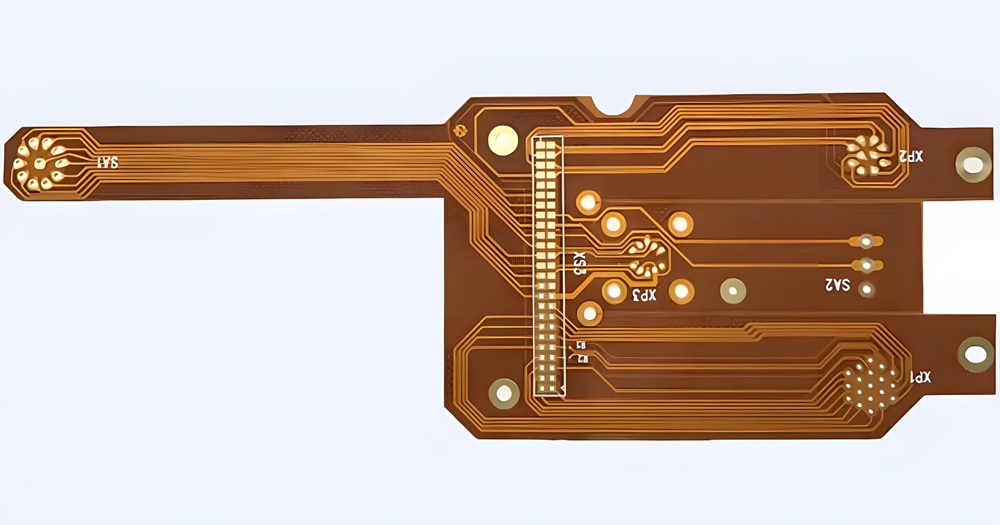With the development of electronic devices towards smaller, thinner and lighter, higher demands are being placed on circuit board design. The stacked design of Flexible Printed Circuit (FPC) boards, with its unique space utilization advantages and performance enhancement, has shown great potential in the field of electronics manufacturing.
What is FPC lamination?
Flexible Printed Circuit Boards, often referred to as Flexible Circuit Boards,Flexible PCBs, Flexible Circuits, or Flexible Printed Circuits, are specialized circuit boards that utilize a flexible substrate to accommodate a variety of shapes and configurations. Unlike traditional rigid printed circuit boards, flexible PCBs have the unique ability to bend and conform to specific requirements, making them ideal for applications where flexibility is critical. Despite the flexibility, these boards maintain the same components and features as rigid boards.
The technical advantages of Flex PCB stackup design
Space Optimization: The stacked design significantly reduces the size of the board, offering the possibility of miniaturizing electronic devices.
Performance Enhancement: Multi-layer construction provides more wiring layers and signal transmission paths for improved circuit performance and reliability.
Design Flexibility: Designers have the flexibility to design FPC stacks according to the specific needs of the device.

flex pcb
FPC component materials
The main constituent materials of an FPC include the substrate, conductive material, adhesive and cover film. Each material plays an important role in the performance and functionality of the FPC.
1. Substrate: Polyimide (PI): PI is the most common FPC substrate, with excellent heat resistance, mechanical strength and electrical insulation. Polyester (PET): PET substrate price is relatively low, but heat resistance and chemical resistance is slightly inferior to PI.
2. Conductive materials: copper foil: copper foil is commonly used in FPC conductive materials, divided into electrolytic copper foil and calendered copper foil. Electrolytic copper foil has high conductivity, while calendered copper foil has better flexibility and ductility.
3. Adhesives: Epoxy resins: Used to bond copper foil to the substrate, providing strength and durability. Acrylate adhesives: Used in some special applications to provide better flexibility and chemical resistance.
4. Covering film: PI film or PET film: covering the surface of the conductive layer, to provide protection against mechanical damage and chemical corrosion of the conductive layer.
FPC laminated structure
Depending on the application requirements, the Flex PCB stackup structure can be single-layer, double-layer, multi-layer or rigid-flex combination structure. The following are a few common Flex PCB stackup structures:
1. Single-layer FPC: It consists of a layer of conductive copper foil and a layer of substrate, with etched circuit patterns on the copper foil and a protective film covering the surface. Structure: substrate + copper foil + covering film Characteristics: simple structure, low cost, suitable for simple circuit connections.
2. Double-layer FPC: Contains two layers of conductive copper foil separated by a substrate, and the two layers of copper foil are connected by guide holes. Structure: Covering film + Copper foil + Substrate + Copper foil + Covering film Characteristics: Can realize more complex circuit design, improve circuit density and connection reliability.
3.Multi-layer FPC: made of multi-layer conductive copper foil and multi-layer substrate superimposed, the middle through the adhesive layer bonding, the layers are connected through the guide hole. Structure: Cover film + copper foil + substrate + (adhesive + copper foil + substrate) × N + cover film Features: For high-density, high-performance complex circuit design, widely used in advanced electronic equipment.
4. Rigid-Flexible Combination FPC: Combines the advantages of flexible circuits and rigid circuit boards, containing both flexible and rigid areas in one circuit. Structure: the rigid part consists of multi-layer PCB, the flexible part consists of multi-layer FPC, both connected by adhesive layer and guide hole. Features: Provides mechanical stability and flexibility for complex three-dimensional wiring and high reliability connection requirements.
The application of Flex PCB stackup design in electronic devices
Smartphones: In smartphones, the stacked design of FPC multilayer boards is widely used for camera modules, display connections, and so on.
Wearables: The compact space and flexibility requirements of wearable devices make FPC multilayer designs ideal.
Automotive Electronics: In automotive electronic control systems, FPC multilayer board design helps to realize complex electronic system layout and signal transmission.
Challenges and Solutions for Flex PCB stackup Designs
Accurate alignment: Ensuring accurate alignment between layers during the stacking process is one of the key technical challenges.
Thermal Management: As circuit density increases, thermal management becomes an important factor to consider in design.
Material Selection: Selection of suitable flexible substrates and conductive materials to ensure the performance and durability of FPC multilayers.
FPC plays an important role in electronic products due to its unique flexible and high density characteristics. Understanding flex pcb constituent materials and stackup structure helps to better design and apply FPCs to meet the needs of different electronic devices. At iPCB, as an industry-leading supplier, we understand the importance of FPC stackup analysis and offer comprehensive solutions tailored to meet customer-specific project requirements.